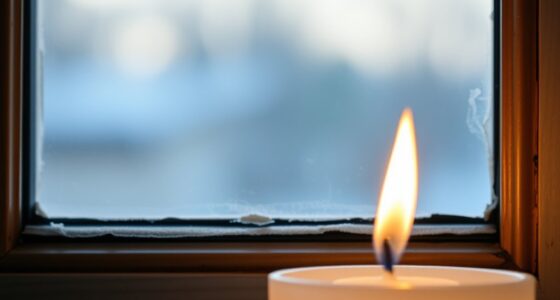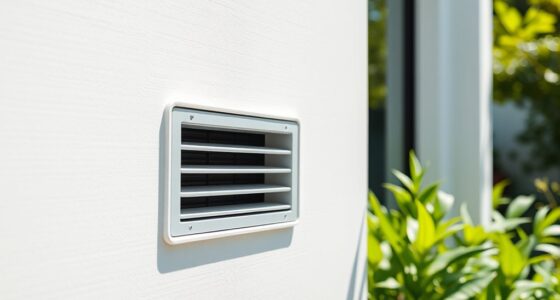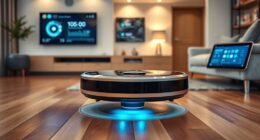To enjoy quiet nights, choose air purifiers and fans with low decibel ratings, ideally below 30 dB, and features like sleep mode to reduce noise. Place devices away from your bed, behind furniture, or inside soundproof barriers to block sound. Regularly maintain filters and components to prevent extra noise from strain. Incorporate white noise or ambient sounds to mask any residual sounds. For more effective tips, keep exploring how to optimize your sleep environment.
Key Takeaways
- Regularly replace filters and perform maintenance to prevent motor strain and reduce noise from purifiers and fans.
- Choose models with noise reduction features, low decibel ratings, and sleep modes for quieter nighttime operation.
- Position devices behind furniture or soundproof barriers and elevate them to minimize sound transmission and vibrations.
- Use ambient sound machines or apps to mask device noise and create a calming sleep environment.
- Set timers and adjust fan speeds to operate only when needed, reducing unnecessary noise during sleep hours.
Understanding Noise Levels in Purifiers and Fans

While purifiers and fans are designed to improve indoor air quality and comfort, their noise levels can vary considerably. One key factor influencing noise is how often you need to perform filter replacement; clogged filters often make devices work harder, increasing noise. Regular filter changes not only maintain air quality but can also help keep noise levels down. Additionally, energy efficiency plays a role—more efficient models tend to operate smoothly and quietly, especially when they’re not overexerting themselves. Cheaper or older units may produce more noise as they struggle to perform, especially if filters are overdue for replacement. By choosing energy-efficient models and staying on top of filter replacement, you can better manage noise levels and enjoy peaceful, quiet air at night. Proper maintenance can also prevent overworking the motor, which is a common cause of increased noise in older or poorly maintained units.
Choosing Quiet Models and Features
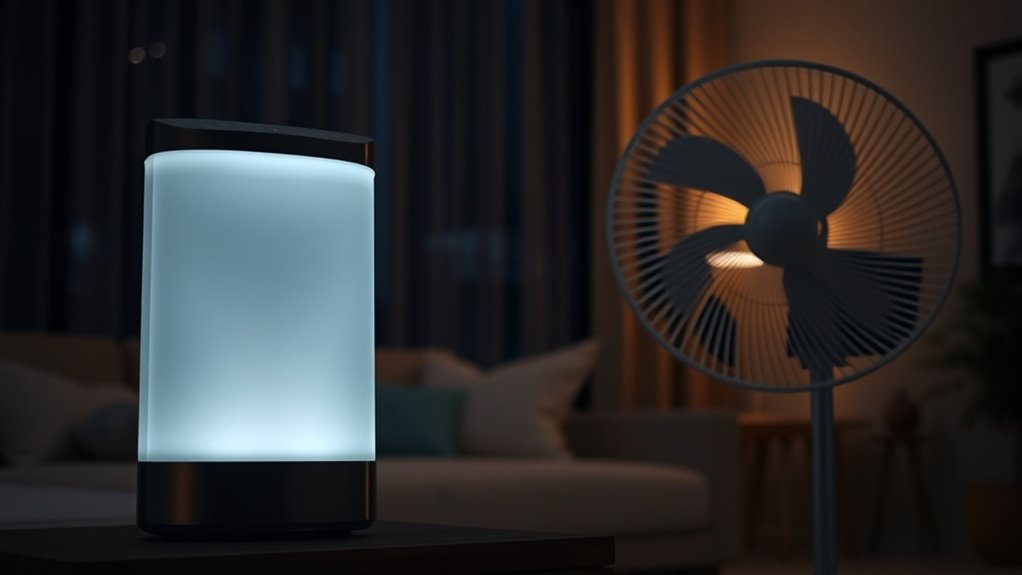
To make certain your purifier or fan operates quietly at night, it’s vital to choose models specifically designed for noise reduction. Look for air purifier filters that are optimized for quiet operation, such as those with multi-layer filtration that minimizes motor noise. Many models feature noise reduction technology, including vibration dampening and sound-insulating materials, which markedly lower sound levels. When selecting, check product specifications for decibel ratings—aim for devices rated below 30 dB for peaceful sleep. Additionally, some brands offer “sleep mode” settings, reducing fan speed and noise further. By prioritizing these features, you guarantee your device runs quietly, providing a restful environment without sacrificing air quality. Properly selecting noise-insulating materials can significantly enhance sleep comfort. Careful selection helps you enjoy clean air and peaceful nights effortlessly.
Proper Placement to Minimize Noise

Proper placement of your air purifier or fan can greatly reduce noise levels during the night. To achieve this, consider the following tips:
- Decorative placement — position the device behind furniture or near decorative elements to mask the noise.
- Outdoor positioning — avoid placing units outside close to windows, as outdoor positioning can amplify sounds.
- Elevate the device — place it on a shelf or stand to prevent vibrations that cause noise.
- Mind the distance — keep the purifier or fan at least a few feet away from your bed for quieter operation and better airflow.
- Choosing the right material — selecting a device made from material options like stainless steel or ceramic can influence heat retention and noise levels.
Using Soundproofing Techniques and Barriers
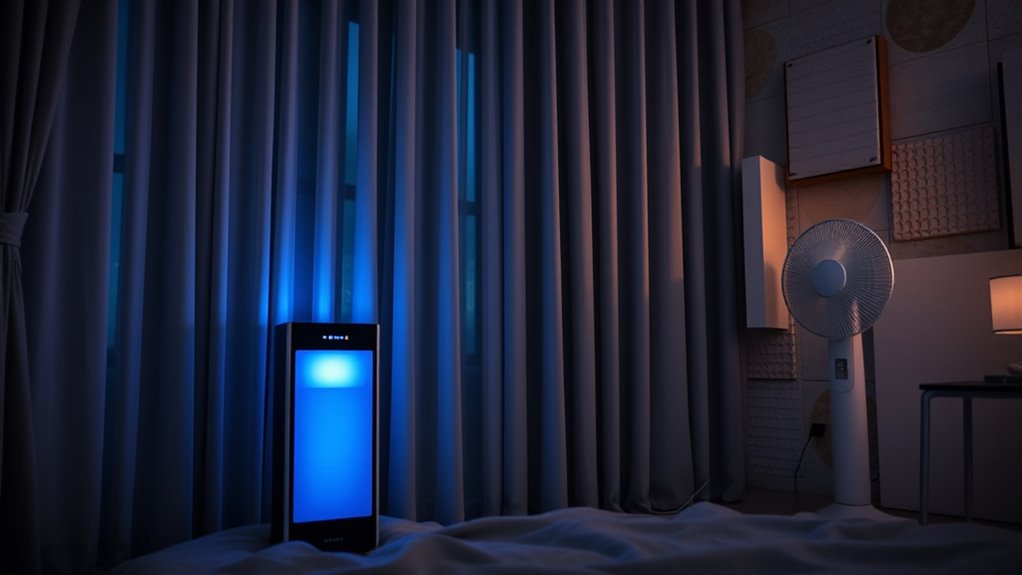
Soundproofing techniques and barriers can markedly reduce the noise from your air purifier or fan, especially during the night. Using soundproof barriers, like acoustic curtains or foam panels, helps absorb and block sound waves, making your space quieter. Acoustic curtains are easy to install around windows or along walls to minimize noise transmission. Positioning your device behind these barriers enhances effectiveness. Combining barriers with strategic placement creates a quieter environment. Incorporating dog-friendly soundproofing methods can also benefit pets sensitive to noise during nighttime.
Adjusting Settings for Quieter Operation

You can make your air cleaner and quieter by adjusting some settings. Turning on sleep mode reduces noise and energy use, while lowering the fan speed can make a noticeable difference. Don’t forget to set the timer so the unit operates only when needed, keeping noise to a minimum throughout the night. Additionally, selecting the best airless paint sprayer for your project can also contribute to quieter operation by providing a smoother finish with less noise during application.
Subheading 1: Use Sleep Mode
Activating sleep mode on your device can markedly reduce noise levels during the night, creating a more peaceful environment for rest. Sleep mode typically lowers fan speeds and dims indicator lights, minimizing disturbance. To maximize benefits, consider these steps:
- Enable sleep mode on your purifier or fan before bed.
- Keep your device clean to maintain energy efficiency and ideal performance.
- Use timers to automatically switch off or switch to sleep mode after a set period.
- Regularly check for firmware updates to improve energy efficiency and cost savings.
- Adjust the noise reduction settings in the device’s menu for quieter operation during sleep hours.
Subheading 2: Lower Fan Speed
Adjusting the fan speed to a lower setting is one of the simplest ways to reduce noise at night. When you lower the fan speed, it produces less noise, making your sleeping environment more peaceful. Proper noise insulation around your device can also enhance quietness, but reducing speed directly minimizes operational sound. Pay attention to the fan blade design; fans with blades engineered for quieter operation tend to produce less noise even at higher speeds. By setting your purifier or fan to a lower speed, you benefit from decreased noise levels without sacrificing air quality. This simple adjustment helps create a calmer, more restful space—perfect for a quiet night’s sleep. Additionally, selecting a fan with noise-reducing features can significantly improve your nighttime environment.
Subheading 3: Adjust Timer Settings
Since running your device continuously can generate unnecessary noise, setting the timer to turn it off after a certain period can considerably reduce nighttime disturbance. Timer optimization allows you to customize operation times for quieter nights. To make the most of scheduling strategies, consider these tips:
- Set the timer for just enough time to cover your sleep cycle.
- Use quick access buttons for easy adjustments before bed.
- Program the device to turn off after your preferred duration, avoiding prolonged noise.
- Combine timer settings with lower fan speeds for even quieter operation.
- Incorporate soundproofing techniques to further minimize noise disruptions during sleep.
Regular Maintenance to Reduce Unnecessary Noise

Regular maintenance is vital for keeping your air conditioning system quiet at night. One key step is regular filter replacement, which prevents debris buildup that can cause the unit to work harder and produce more noise. Clean filters also improve airflow, reducing strain on the motor. Additionally, motor lubrication is essential; over time, the motor’s moving parts can become dry, leading to squeaks or grinding sounds. Applying proper lubrication minimizes friction and keeps the motor running smoothly. Regularly inspecting and maintaining these components not only quiets your system but also prolongs its lifespan. By staying on top of filter changes and motor lubrication, you guarantee your air purifier or fan operates quietly and efficiently, providing you with a peaceful night’s sleep.
Incorporating White Noise or Ambient Sounds
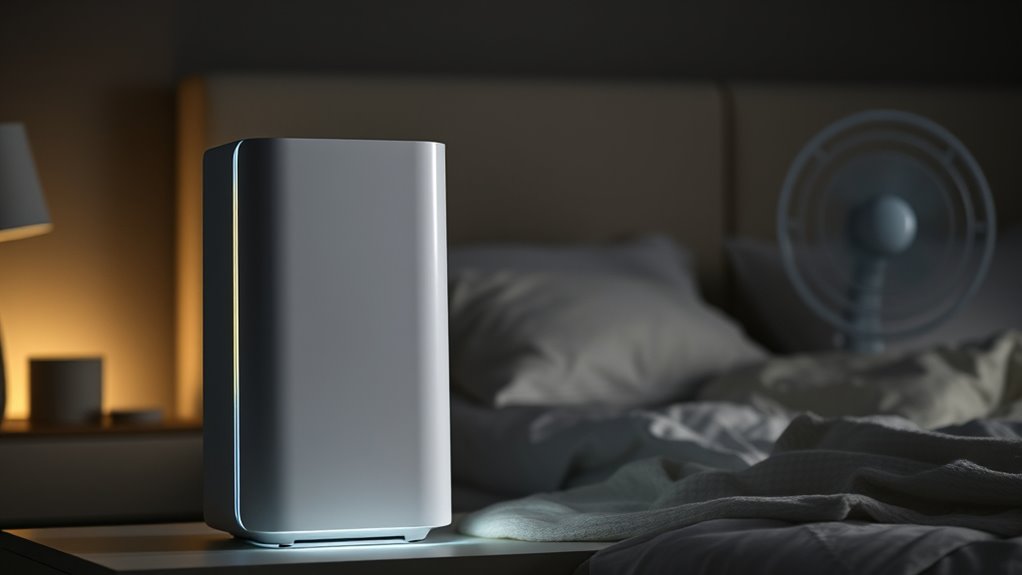
Incorporating white noise or ambient sounds can be an effective way to mask nighttime disturbances and create a more peaceful sleeping environment. Sound masking with calming melodies or gentle white noise minimizes sudden noises that might wake you. Here are some tips to get started:
Using white noise or ambient sounds creates a peaceful sleep environment and masks disruptive nighttime noises.
- Use a dedicated sound machine or app that offers white noise or nature sounds.
- Choose calming melodies that are consistent and not too stimulating.
- Adjust volume levels to ensure sounds are soothing but not overpowering.
- Experiment with different sounds until you find the one that best promotes relaxation.
- Consistent auditory environment helps reduce disruptions and enhances sleep quality.
These techniques help create a consistent auditory environment, making it easier for you to fall asleep and stay asleep through the night.
Practical Tips for Nighttime Use and Sleep Optimization

To make the most of white noise or ambient sounds during the night, it’s important to optimize their use for maximum comfort and effectiveness. Use air quality sensors to monitor your room’s environment, ensuring your purifier or fan maintains ideal conditions without excess noise. Position your device away from your bed to reduce sound intensity while still providing clean air and ambient noise. Set timers or sleep modes to limit energy consumption overnight, saving power without sacrificing comfort. Keep filters and sensors well-maintained for consistent performance and quieter operation. Adjust sound levels gradually to find the optimal balance between noise and silence, creating a soothing atmosphere that promotes restful sleep while keeping energy use efficient. Additionally, understanding predictive analytics can help tailor your device settings based on your sleep patterns and preferences for improved comfort.
Frequently Asked Questions
Are There Specific Brands Known for Silent Air Purifiers and Fans?
You’ll find that brands like Coway, Blueair, and Dyson are known for their silent air purifiers and fans. Their brand reputation is built on quiet operation, and customer reviews consistently praise their low noise levels. When choosing, look for models specifically designed for quietness, and check reviews to confirm they meet your needs. These brands are trusted for blending effective performance with minimal noise, making them ideal for peaceful nights.
How Does Room Size Affect Noise Levels of Purifiers and Fans?
Room size substantially impacts the noise levels of purifiers and fans because larger spaces require more airflow, which can increase noise due to airflow dynamics. In smaller rooms, these devices tend to operate more quietly because the room’s acoustics absorb some sound, and less airflow is needed. To minimize noise, choose units with adjustable settings, and consider how room acoustics influence sound, ensuring your space remains peaceful at night.
Can Noise-Reducing Accessories Improve Existing Air Purifiers or Fans?
Think of noise-reducing accessories as a calming balm for your air purifier or fan. They can substantially improve noise dampening, making your device quieter at night. Before purchasing, check for accessory compatibility with your model to ensure seamless integration. These accessories can help transform a noisy machine into a peaceful presence, allowing you to enjoy restful sleep without sacrificing air quality or comfort.
Do Noise Levels Vary Between Energy-Efficient and Traditional Models?
Yes, noise levels often vary between energy-efficient and traditional models. Energy-efficient units tend to operate more quietly because they focus on optimized energy consumption, reducing overall noise comparison. While some traditional models might be louder due to higher power usage, many energy-efficient options incorporate quieter motors and sound-dampening features. You’ll find that choosing an energy-efficient purifier or fan can help you enjoy quieter nights without sacrificing performance.
Are There Health Risks Associated With Very Quiet or Silent Devices?
Like the silent whisper of a ghost, very quiet devices pose minimal health risks, but you should still consider hearing safety. Prolonged exposure to any loud noise can harm your hearing, yet near-silent devices are unlikely to affect your health. Make certain your device operates within recommended noise levels to protect your hearing safety and avoid potential discomfort or stress. Always check manufacturer guidelines for maximum safe noise levels.
Conclusion
By following these tips, you can enjoy peaceful, quiet nights without sacrificing clean air. Choosing the right purifier or fan, placing it wisely, and maintaining it regularly will make a big difference. Don’t forget to try soundproofing or background noise to drown out any remaining hum. With a little effort, you’ll have your cake and eat it too—sleep soundly while keeping the air fresh and clean. Nighttime tranquility is well within your reach!


